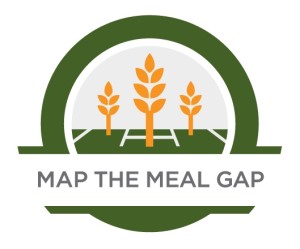Map the Meal Gap Shows Hunger in Every Maine County

On Monday April 21, 2014 Feeding America released its annual Map the Meal Gap study, which determines food insecurity rates in every county in the United States. The research shows that 15.5 percent of Mainers, or 206,000 people, are food insecure, meaning they lack access to adequate food.
The study also confirms that 24 percent of Maine children, or nearly 1 in 4 of our kids, are not receiving the nutritious food they need to learn, grow, and thrive.
Nationwide, 15.9 percent of the population is living with food insecurity. While nationally, the food insecurity rate has decreased slightly in recent years, here in Maine the rate has actually grown, according to this research.
Map the Meal Gap 2014 is a detailed analysis of food insecurity done by Feeding America and the only study available that provides county-level estimates of food insecurity in the United States. The USDA Economic Research Service measures food insecurity on the national level each year. The most recent data from USDA, which was used in the Map the Meal Gap analysis, reflects food insecurity rates in 2012.
To share information from Map the Meal Gap, Feeding America created an interactive map that allows viewers to find out how widespread hunger is in their community. The map can be found at www.feedingamerica.org/mapthegap.
Key findings for Maine include:
- 15.5 % of people are food insecure
- 24.1 % of children under 18 are food insecure
- Washington County has the highest rate of food insecurity in Maine (17.6%) and Lincoln County has the lowest (12.9 %)
- Washington County has the highest rate of child food insecurity in Maine (28.1 %) and Cumberland County has the lowest (20.3 %)
- 36 % of food insecure people are above 185 % of poverty, meaning they do not qualify for programs such as SNAP (food stamps) and must rely on charitable hunger relief efforts
- 36 million meals were missing from Maine tables in 2012
About Map the Meal Gap:
The Map the Meal Gap 2014 analysis was developed by Dr. Craig Gundersen for Feeding America. Food-insecurity rates are based on a state-level model that allows for the population in need of food at the county and congressional district level. Additionally, Feeding America worked in collaboration with Nielsen to arrive at estimates for food-cost variation by county. Results were reviewed by the Feeding America Technical Advisory Group in order to ensure accuracy and promote transparency. Research for the study was generously supported by the Howard G. Buffett Foundation, ConAgra Foods Foundation and Nielsen.
A summary of the findings, an interactive map of the United States, and the full report are available at www.feedingamerica.org/mapthegap.